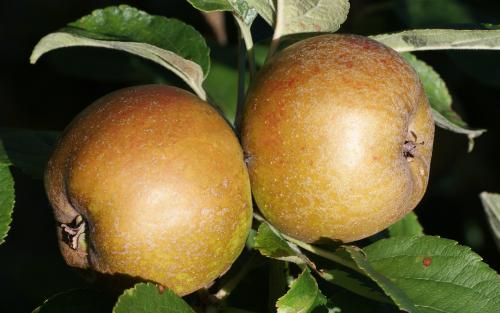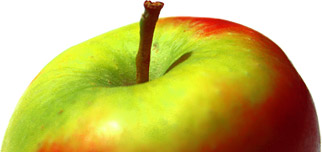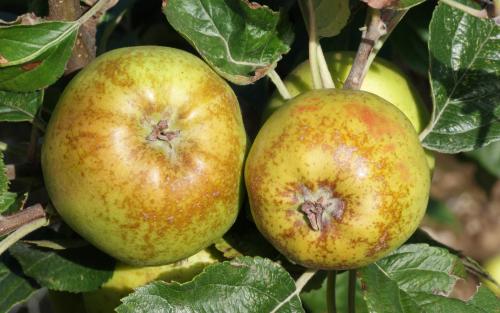
D’Arcy Spice is an old apple variety originating near Colchester, Essex, prior to 1800. D'Arcy Spice is a rather slow-growing tree that is fairly tolerant of relatively poor soils, sandy soils, windswept areas and salty air - conditions in which many apples will not thrive. However, on poor soils, a strong rootstock would be required – such as MM111 or M25. The tree flowers mid-season, often on the tips of branches, but also on a moderate number of spurs. Blossom is the usual pink buds, becoming almost white once the flowers are open. The substantial amount of tip-bearing of the fruit gradually weighs down the upright branches and transforms the tree from a very upright shape, into the more normal spreading shape associated with apple trees.
D’Arcy Spice has a reputation for somewhat variable cropping from one year to the next in many parts of the UK and has a distinct preference for being grown in the warmer and drier East or South East, with the best fruits usually being produced on relatively drier, warmer and poorer soils.
Although D’Arcy Spice is officially stated to be self-incompatible, it usually has a good pollination rate for its flowers and will sometimes produce seedless fruits. Fruits are average size, somewhat knobbly at the base, mostly dull green, with patches of light brown russet and a dull purplish-red sunny side. The skin is quite tough which is probably what gives the fruits some resistance to scab and insect damage. In windy weather, the fruits cling to the tree, with few windfalls.
The fruit is picked very late in the season - often early November. In cooler or less sunny parts of the UK, the fruits may not ripen properly and therefore may be poorly flavoured; failing to achieve the flavour which makes this variety famous. When first picked, the apples are hard and sharp-tasting, with a reasonably tough skin. The storage qualities are very good, with fruits often remaining in good condition until the following spring. Historically the fruits would be stored for a month or two before they became edible. The mature fruits will also tolerate being lightly frosted without apparently being damaged, while the previous season’s windfalls can often be found lying in the grass in late winter, looking as fresh as the day they fell off the tree in the previous autumn. During storage, after a good year, the fruits sweeten and become a pleasant flavour, with hints of "sweet spice" rather like mince-pie filling (apple, cinnamon and raisins) which gives the variety its name.
In addition to the trees tolerance of relatively poor growing conditions, D’Arcy Spice has some useful resistance to diseases - the fruits have some resistance to scab and insects, although the leaves are easily scabbed by heavy rainfall and its already-slow-growing tendency will be slowed even further in wetter parts of the UK, as a result of leaf damage caused by scab. D’Arcy Spice also has a good level of resistance to powdery mildew; a disease which is common on poor soils of the kind where D'Arcy Spice may grow. It also has some tolerance to canker infection. Due to the slow-growing nature of this variety, it is best grown on a stronger rootstock than would normally be used to achieve the desired tree size, although it may continue growing after its companion trees have reached mature size, resulting in D'Arcy Spice eventually becoming almost average in size. D’Arcy Spice is probably not suitable for a one-tree garden, but may be useful as the late-keeping part of a balanced collection of several trees intended for almost year-round apple supplies. Such a collection might include one early-ripening eater, one early-mid cooker, one mid-season eater, one late-season cooker and two late-keeping eaters.
All in all, D'Arcy Spice is an unusual apple variety. Some researchers have speculated that it might be a haploid (single set of chromosomes) rather than the more usual diploid (two sets of chromosomes) of most apple varieties. This might explain its slow growth, poor pollination of other varieties, and the frost resistance of the blossom (haploid cells are smaller and more resistant to the bursting effect of frost).
We are grateful to apple enthusiast N.Buck for the above details.
D'Arcy Spice apple identification images
All images copyright Orange Pippin unless otherwise stated.
USDA identification images for D'Arcy Spice
The identification paintings in the USDA Pomological Watercolor Collection span the years 1886 to 1942.
Citation: U.S. Department of Agriculture Pomological Watercolor Collection. Rare and Special Collections, National Agricultural Library, Beltsville, MD 20705.
Visitor reviews
- 22 Apr 2019 SOMERSET, United KingdomBought December 2016 as a very young tree. Planted in a sheltered garden with no other apple tree in the garden. First fruit gathered 2018 and stored. Only two apples were allowed to grow, other being removed as soon as the blossom was over. The first fruit was 155g picked in October, the second 195g picked in November, therefore not accounting that it was the smaller of the two, it has gained at least 25% in weight over six weeks. It was still very firmly attached to the tree and I wonder whether it could have been left even longer. We shared one between all of us on Christmas Day, the second on boxing day, best apple tasted. First flowering 2019 15 April but it has been a very warm and dry spring. I am following the progress of this tree on my blog.
- 31 Oct 2017 ESSEX, United KingdomI was born in Tolleshunt Major and there were three D’Arcy Spice trees in our garden and loved the flavour of these apples. They were always picked in November after a frost and lasted well into the spring. I was delighted to find a supplier and bought a young tree from Ken Mewers and it has flourished and provided a bountiful harvest of fruit every year. I use this fruit for pies and crumbles as well and I’m more than satisfied.
- 17 Oct 2016 WASHINGTON, United StatesSince I cannot find anyone within 100s of miles who grows D'Arcy Spice, I bought a bench graft from Greenmantle, on Bud118. It has grown slowly and bloomed at the top the last several years, but fruit drops off as soon as we pass 34C (90F). It seems just too arid in eastern Washington. I'll have to go on a road trip to taste this some day.
- 24 May 2015 OREGON, United StatesI have a D'Arcy Spice which I obtained as a fresh graft from a rosarian in Ettersburg, in northern California, about 7 years ago. This whip grew slowly in a crowded part of my garden until last year, when I transplanted it to a sunny nursery bed, where it grew to a bushy three feet in height. I shall plant it in row in my orchard this week. It flowered this spring but I Don't expect it to bear fruit, owing to the transplant shock. It is vigorous, beautifully leafy, with no sign of leaf curlers, the yearly nemesis here in Western Oregon among the Coast Range of mountains.
- 26 Nov 2013 United Kingdomgrown as a cordon, we left our d'Arcy spice later this year, only picking this week (last Nov.). Flavour and texture best of all our apples (15 var.) including our one large tree Norfolk Royal.
- 17 Nov 2013 DERBYSHIRE, United KingdomI was born at Goldhanger some2.5 miles from Tolleshunt Darcy. We had a large Spice tree as it was called which cropped regularly and also a seedling which was true but had larger apples. As a native I regarded it the Doyenne du Comice of apples. It was grown commercially by Rex Page in the village and also by the Smyth family a mile or two away. I believe the latter still do so. I was hoping to find a supplier when I came across this site. I would love some for Christmas.
- 27 Nov 2011 WILTSHIRE, United StatesI grow one of these trees as an espalier on dwarfing stock. Contrary to expectations it is a vigorous tree which produces a heavy crop very reliably on fairly dry chalky loam. It is more resistent to insect and woodlouse damage than my other varieties. Its flavour is variable, at best it is sweet, juicy with a hint of something...well maybe spicey but I'm not sure. This year (2011) we will be eating the apples well into 2012 by which time they will have shrivelled a bit but will still taste fine. I agree with the comment about frost resistence from N. Buck. Apart from the slightly dull appearance of the fruit, I can't imagine why these apples are not found in every supermarket in the country.
- 08 Mar 2011 CHESHIRE, United KingdomI would love to buy one of these unusual apple trees as its hardiness would do very well here. Do you know of a supplier.
- 16 Sep 2010 CONWY, United KingdomI was brought up on the Essex/Suffolk border and my grandparents had a d'Arcy spice apple tree in their garden which I remember well with fond affection. My father grew a seedling from this tree which was true to the parent tree and I used to take boxes of the apples with me to eat in my digs in London in the 1960's. I forgot about them being in the boot one year and they were subjected to more than a fortnight of severe frost with no ill-effect before being found and eaten. It used to be said that they should not be picked until well into November and preferably after a good frost which improved their flavour. A truly special apple for eating in front of a roaring Christmas fire - peeled first though. Nigel Holmes
- 14 Aug 2010 CAMBRIDGESHIRE, United KingdomIn the frosty spring of 2010, my D'Arcy Spice trees were caught by several frosts while in full blooms; down to about -4'C on one or two occasions. Despite the frosts, the trees have set a normal crop while most of my other varieties have failed. A few other growers of D'Arcy Spice have also tentatively suggested good frost resistance. They have also suggested that D'Arcy Spice has some resistance to fireblight - presumably because its slow-growing habit means that it has fewer young shoots (and fewer blossoms), which are the usually sites for fireblight entry.
Tree register
United States
- Albany Appleguy in Castleton, NY
- Axel Kratel in Santa Cruz, CALIFORNIA
- Carolina Nurik in Vashon, WA
- Dan Spratlen in Camano Island, WASHINGTON
- Dave Liezen in Spokane, WA
- Gina Colver in EPHRATA, WASHINGTON
- Jady Morelli in Allendale, MI
- Jimj in Kenwood, SONOMA COUNTY, CALIFORNIA
- John A Gasbarre in Saco, MAINE
- Nathan Parker in Mount Shasta, CA
- Richard Smith in Plymouth, MA
United Kingdom
- Reach Community Orchard in Cambridge,
- Reach Community Orchard in Cambridge,
- Reach Community Orchard in Cambridge,
- Alison Quinsey in Beccles, SUFFOLK
- Andrew Colchester in Bures, SUFFOLK, UK
- Annette Hurt in Filby, NORFOLK
- Barbara Brown in Gt. Yarmouth, NORFOLK
- Bernard in Wickham Bishops, ESSEX
- Bill Barker And Sharon Cherry in Leicester, CHERRYLEATHER@GOOGLEMAIL.COM
- Bill Barker And Sharon Cherry in CHERRYLEATHER@GOOGLEMAIL.COM
- David Harmston in Sleaford, LINCS
- Dr Dennis Bancroft in Near Rugby, NORTHAMPTONSHIRE
- Edward Evans in Manningtree, SUFFOLK
- Graham Charles Schofield in Newmarket, SUFFLOK
- Helen Carrick in RIVENHALL, WITHAM, ESSEX
- Jude Ilett in Peasenhall, SUFFOLK
- Lucy & Jonathan Bowden in Long Hanborough, OXFORDSHIRE
- Michael Adams in Halifax, WEST YORKSHIRE
- N. Buck in Cambridge, CAMBRIDGESHIRE
- N. Buck in Cambridge, CAMBRIDGESHIRE
- N. Buck in Cambridge, CAMBRIDGESHIRE
- N. Buck in
- Nigel in CAMBRIDGE, CAMBRIDGESHIRE
- Paul Collins in Warminster, WILTSHIRE
- Peter Barnard in Doncaster, LINCOLNSHIRE
- Rupert in Holnest, DORSET
- Steve Webster in Truro, CORNWALL
- Suzanne Goss in Hailsham, EAST SUSSEX
- Victoria Birkett in Aberdeen, SCOTLAND
- Warren in Glasgow, STRATHCLYDE
Ireland
- Lars Christoffersen in TRIM,
Italy
- Ilario in Fossano, CUNEO
Netherlands
- Cheuk A Lam in Amsterdam, NOORD-HOLLAND
Canada
- Roger Macpherson in Delta, B.C.
Spring blossom records for this variety
2018 season
- 6th May 2018 - tree owned by Bill in , United Kingdom
2017 season
- 4th May 2017 - tree owned by Bill in Leicester, United Kingdom
2016 season
- 11th May 2016 - tree owned by Bill in Leicester, United Kingdom
2014 season
- 5th May 2014 - tree owned by Michael in Halifax, United Kingdom
2013 season
- 21st May 2013 - tree owned by David in Sleaford, United Kingdom
2011 season
- 24th April 2011 - tree owned by Barbara in Gt. Yarmouth, United Kingdom
2010 season
- 6th May 2010 - tree owned by N. in Cambridge, United Kingdom
- 2nd May 2010 - tree owned by N. in Cambridge, United Kingdom
- 29th April 2010 - tree owned by N. in Cambridge, United Kingdom
2009 season
- 2nd May 2009 - tree owned by N. in Cambridge, United Kingdom
- 2nd May 2009 - tree owned by N. in Cambridge, United Kingdom
- 19th April 2009 - tree owned by N. in Cambridge, United Kingdom
Record your blossom dates in our Fruit Tree Register - more >>.
Harvest records for this variety
Origins
- Species: Malus domestica - Apple
- Parentage: Unknown, possibly a member of the Nonpareil family of apples
- Originates from: Essex, United Kingdom
- Introduced: 1800s
- Developed by: Possibly a seedling raised in the gardens of Tolleshunt D'Arcy Hall, Essex
- UK National Fruit Collection accession: 1942-006
Identification
- Country of origin: United Kingdom
- Period of origin: 1750 - 1799
- Fruit colour: Russet
- Flower colour: White
- Leaf colour: Green
- Popularity: Rarely grown
- Annual cycle: Deciduous
Using
- Picking season: Very late
- Keeping (of fruit): 3 months or more
- Flavour quality: Very good
- Flavour style (apples): Aromatic
- Cropping: Light
- Food uses: Eating fresh
- Food uses: Culinary
- Food uses: Juice
- Picking period: early November
- Wildlife: RHS Plants for Pollinators
Growing
- Gardening skill: Experienced
- Flowering group: 4
- Pollinating others: Poor
- Ploidy: Other
- Vigour: Weak growing
- Precocity: Slow to start bearing
- Fruit bearing: Spur-bearer
- Organic culture: Suitable
- Longevity: Long-lived
- Self-fertility: Partially self-fertile
Climate
- Frost resistance of blossom: Good resistance
- Climate suitability: Temperate climates
- Climate suitability: Mild damp climates
- Summer average maximum temperatures: Cool ( 20-24C / 68-75F)
Other qualities
- Disease resistance: Good
- Powdery mildew: Very resistant
- Bitter pit: Very resistant
- Canker: Some resistance
- Scab (Apple and Pear): Some resistance
Where to buy fresh fruit
The following orchards grow D'Arcy Spice:
United States
Maine
- Tiny Orchards, Saco
Michigan
- Alber's Orchard & Cider Mill, Manchester
New York
United Kingdom
England - south-east
- Lavenham Brook Vineyard and Orchard, Sudbury
References
- Apples of England (1948)
Author: Taylor


